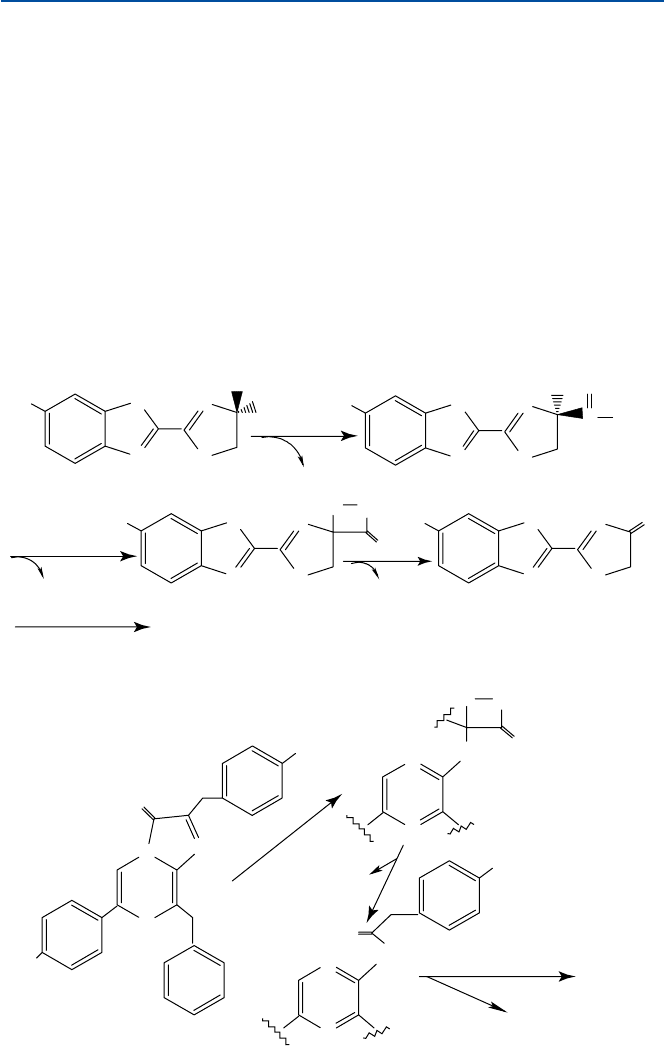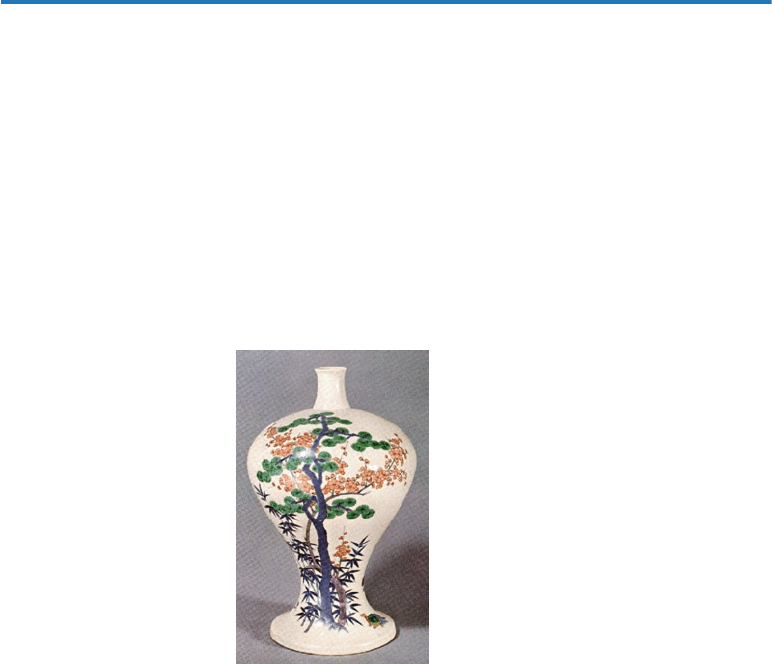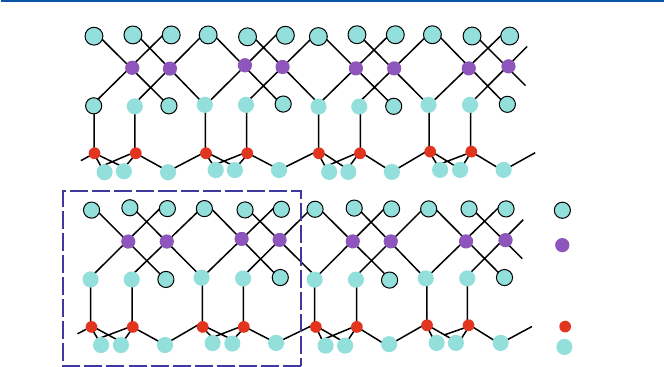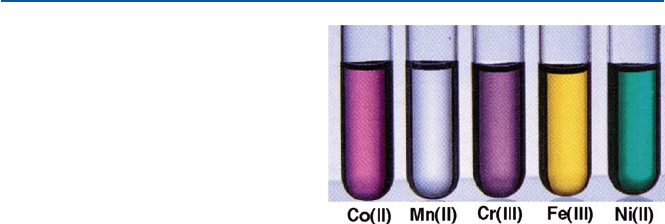Ochiai E. Chemicals for Life and Living
Подождите немного. Документ загружается.


122
9 Light Stick, Firefly, and Color TV
The bioluminescence reaction involves a compound called luciferin, an enzyme
luciferase and oxygen (O
2
). [Lucifer is the morning star and is a light-bearer]. Luciferin
and luciferase are collective names and differ from a species to another. Luciferin
used in fireflies is luciferin (benzothiazole), but that in some fish, shrimp, squid, and
some jellyfish is called coelenterazine and is a different compound from firefly
luciferin. Some bacteria use an ordinary compound called flavin mononucleotide
(FMN, which is used in all organisms for different purposes), and dinoflagellates (and
some shrimp) use yet another compound. The luciferin used in crustacean (and some
fish) is called vargulin. All these compounds, however, have similar reacting portions
where the crucial reaction, oxetane formation, takes place. We will look at fireflies
and ceolenterazine to illustrate how light is created.
The chemistry of these light-producing processes is summarized in Fig. 9.2. You do
not have to worry about the details of chemistry. As usual, chemicals are described by
N
S
N
S
HO
H
COOH
N
S
N
S
HO
H
C
O
AMP
ATP
PP
i
N
S
N
S
HO
N
S
N
S
HO
B(base),
O
2
BH
+
, AMP
OO
O
O
Luciferin
*
CO
2
Oxyluciferin
(* excited state)
Luciferin Light
+
Firefly Luminescence
HO
N
N
N
OH
O
N
N
N
O
O
O
O
2
N
N
N
OH
*O
CO
2
Light
Ceolenterazine
Jerryfish Luminescence
H
H
H
Fig. 9.2 Bioluminescence

1239.4 Color TV and Color Monitor of Computer
chemical formula. Luciferase, the enzyme which fireflies produce (this is a very
complicated chemical and is not shown), binds the chemical luciferin. However, in this
case, luciferin itself is not sufficiently energetic and needs to bind AMP (adenosine
monophosphate). You recall that ATP (adenosine triphosphate) is a universal energy
carrier in the living organisms. What it does is to provide chemical energy for a chemical
reaction that needs such an energy input. So upon binding a part of ATP in the form of
AMP, luciferin is energized. This energized luciferin then reacts with oxygen (O
2
of
the air) and forms the square-shaped unit with an O–O bond and a C=O bond (Fig. 9.2).
This unit (oxetane) is very unstable (highly energetic) and spontaneously decomposes
into carbon dioxide (CO
2
) and the carbonyl unit (C=O). The energy present in the
oxetane is left with the carbonyl unit; the star (*) attached to the C=O unit indicates
that it is in a highly energetic (excited) state. This compound (called oxyluciferin) then
emits a light of greenish yellow color and comes down to the most stable state (ground
state). Oxyluciferin is then recycled chemically back to luciferin. This is what chemists
think to happen, but they have not yet figured out the complete picture of the process.
The luminescence of firefly is very sensitive to the presence of the energy carrier
ATP and is also sensitive to luciferase (the enzyme) in the presence of ATP and
luciferin. So it provides a sensitive means to detect small quantities of ATP or
luciferase. If firefly luciferase gene is coupled to a DNA containing some other genes
and that region is expressed, luciferase is produced and instantly emits light (in the
presence in the necessary chemicals). This light emission is an indicator of that por-
tion of DNA being expressed and is conveniently used as a reporter for such events.
In the case of coelenterazine (of a jellyfish) as well, the crucial reaction interme-
diate is the formation of the square-shaped unit (oxetane) as seen in Fig. 9.2. This
unstable intermediate decomposes spontaneously and forms an excited state of the
carbonyl group; it then emits a light as it goes down to the ground state. This process
requires the presence of calcium ion (Ca(II)), and hence this coelenterazine biolu-
minescence system is a sensitive detector of calcium.
There is another kind of protein that emits green light in jellyfish and others; it is
called Green Fluorescent Protein (GFP). This protein, however, does not fluoresce
on its own device. It needs to be excited by extraneous light. It is often used as a
marker protein. The gene of GFP is incorporated along with that of another protein
(which is the purpose of a genetic engineering) in a vector (e.g., a plasmid of E. coli).
Whether the target protein is expressed or not can be judged by shining light on the
cells. If the protein is expressed (produced), the associated GFP is also produced
and the protein molecules expressed will show up as glowing green spots. The dis-
covery of GFP and its application were rewarded with a Nobel prize in chemistry in
2008 (Osamu Shimomura, Martin Chalfie and Roger Y. Tsein).
9.4 Color TV and Color Monitor of Computer
The color TV or computer monitor (of now obsolete type) makes use of fluores-
cence, that is, an immediate light emission when a substance is excited or given an
energy. In principle, its color is obtained in the same manner as those involved in
fireworks. That is, “excite an atom or a compound and then it will emit light.”

124
9 Light Stick, Firefly, and Color TV
The only difference is the way of excitation. In fireworks, high temperature (heat) is
the energy source of excitation, whereas in the case of the color TV screen, the
energy source is an electron beam. Because of the difference in the setting and the
energy source, the coloring material used for fireworks is not quite suitable for color
TV screen.
All million different colors can be obtained by mixing three fundamental colors:
blue, green, and red. The TV screen is covered with millions of spots, and each spot
consists of blue, green, and red dots. An electron gun targets an electron beam at a
red dot at one instant, and simultaneously the other two beams hit blue and green
dots, respectively. The size of the dots is about 8–10 mm. We cannot see them as
separate dots. [Micrometer is one millionth of a meter or one thousandth of a milli-
meter]. The beam intensity determines the color intensity. The combination of these
three colors of differing intensity brings about various colors.
Well then, what are those dots made of? They are made of inorganic compounds;
they are typically resistant to repeated bombardment of electrons. They have to be.
Blue is usually obtained by silver ion impregnated in zinc sulfide: Ag
I
:ZnS. The
electron in Ag
I
is hit by an electron beam and excited to a higher level. Soon the
electron comes back down to the ground level, emitting blue light. How soon deter-
mines the so-called decay time. This one has a medium decay time. If the decay
time is too short, the television screen flickers and makes viewing difficult, but on
the other hand, if it is too long, the television image will be blurred, because an
image is overlapped by the previous image. The green emission is from copper
impregnated in zinc sulfide (Cu
I
, (Al
III
):ZnS). An exotic element, europium, provides
the red color; Eu
III
:Y
2
O
2
S (Eu = europium and Y = yttrium).
The requirements for computer monitors are slightly different. First, the monitor
requires a higher resolution. Hence, the size of particles (dots) must be smaller, typi-
cally 4–6 mm. Another difference is that it usually reproduces slower movements
than televisions. This necessitates the longer decay time of the fluorescence. The
materials used are similar to those used in the television screen, but they are modi-
fied to make longer the decay time, by adding some other components.
Liquid crystal display (LCD) and plasma display in recent TVs and computer
monitors are based on entirely different principles and material and are not
discussed here.

125
E. Ochiai, Chemicals for Life and Living,
DOI 10.1007/978-3-642-20273-5_10, © Springer-Verlag Berlin Heidelberg 2011
Old and yet New staff
Pottery is probably one of the oldest craft mankind invented. It is believed that it
may go back as long ago as 10,000 B.C. Yet it is still being used for practical as well
as for artistic purposes, and generalized ceramics are now being pursued as high-
tech material. That is, “ceramics is the oldest and yet the newest material.”
Even those Paleolithic people who made jars and basins out of clay could not
help but decorate them and also use the technique to create something pleasing and
aesthetic without practical uses. Humankind, with its creative brain, cannot help but
do something beyond absolute necessity. That has brought us “civilization” and
“culture.” Pots, the artifact, are actually often used to distinguish ancient civiliza-
tions, and how cultures were transmitted from one location to another. The reason is
the long-lastingness of the ceramics. They are one of the sturdiest chemical materials.
10
Ceramics

126
10 Ceramics
They are essentially “rock,” the inorganic material. The other artifacts made of
plants or animal materials are organic materials, which are subject to chemical,
physical, and biological decomposition. Particularly vulnerable are they to the
attack by microorganisms, fungi, and bacteria.
10.1 Chemicals that Make Up Ceramics/Pots, and What
Happens to Them When Fired in a Kiln?
The conventional ceramics, brick, earthenware, and porcelains, are made from clay.
Clay is a complex material, but its main component is a mineral called “kaolinite.”
Pure kaolinite is a nice white powdery mineral. Such white clay is called “China
clay.” Clay is often colored though, because it contains small quantities of colored
material such as iron oxide (Fe
2
O
3
) that gives a brownish color. Other iron com-
pounds present give grayish colors. All iron compounds turn into iron oxide (Fe
2
O
3
)
when fired, and hence the earthenware made from grayish clay usually ends up with
a brownish color. Ordinary clays contain in addition other minerals such as quartz,
soda mica (paragonite), and potash mica (muscovite).
One of the common minerals in granite rock is “feldspar,” which has a chemical
composition of K
2
O×Al
2
O
3
×6SiO
2
[K is potassium, Al is aluminum, and Si is sili-
con]. Over the geological time, rocks containing feldspar are slowly weathered, and
the mineral reacts with water and carbon dioxide in the air, and turns into kaolinite.
The chemical reaction can be approximated as follows:
( ) ( ) ( )
( ) ( ) ( )
2 23 2 2 2
23 2 2 2 3 2
K O Al O 6SiO feldspar 2H O water CO carbon dioxide
Al O 2SiO 2H O kaolinite K CO dissolved away 4SiO free silica
⋅⋅ + + →
⋅ ⋅ + +
The chemical composition of kaolinite can also be expressed as Al
4
Si
4
O
10
(OH)
8
;
this formula represents better the crystal structure of the mineral as shown in
Fig. 10.1 (as in a unit of the crystal (dashed line box), only two layers and two such
units in each layer are shown). The crystal consists of layers of a sort of sheet which
has the composition of Al
4
Si
4
O
10
(OH)
8
(see more about the chemistry of rocks in
Chap. 14).
One of the important properties of clay is its plasticity when it is wet. In other
words, it can be molded in any form you want, and the shape will hold when you
release your hands from it. Why is wet clay plastic? When water is added, water
molecules actually bind to the surfaces of clay mineral (kaolinite) [this phenomenon
is called “adsorption”]. What kind of chemical force binds them? This happens
readily because of its chemical structure as shown in Fig. 10.1. Water acts then as
glue holding clay particles together (due to surface tension). However, when you
apply stresses (i.e., try to create a shape) sufficiently strong, water makes the flow
(movements due to the stress) of particles easier. In other words, water can act like
a lubricant as well. The clay particles are easy to flow because of its plate-like struc-
ture (Fig. 10.1). When the stress is removed, the flow stops and the effect of water
of holding together the particles resumes; hence the shape will be maintained.

127
10.1 Chemicals that Make Up Ceramics/Pots, and What Happens to Them…
Further, when dried, the article becomes fairly rigid and strong, in the sense that it
maintains its shape against a significant stress. This phenomenon is not very well
understood. If you compact dry kaolinite powder, it will not very well be stuck together,
and any ball formed will easily be crumbled. Therefore, we have to assume that water
molecules that have been used have brought those small particles closer together and
increased the close contacts among particles (so that the clay particles stick together
better now) or water have formed some soluble cementing compounds.
In practice, you need more than just kaolinite to make a pot or a jar. The clay
should contain the so-called flux and filling material. Flux is a mineral which melts
and forms glass at temperatures lower than that at which kaolinite melts, so that this
glassy matrix acts as a cementing agent between kaolinite mineral particles. The
commonly used flux is feldspar (potassium (K
+
)-containing one as seen earlier, or
sodium (Na
+
)-containing one) and its derivatives. The presence of either potassium
or sodium in these minerals reduces the melting point (temperature), and, when
cooled, they tend to become glassy, rather than forming crystals. The filling materi-
als often used are silica (quartz, chemically SiO
2
), alumina (Al
2
O
3
), and calcined
bone (chemically apatite Ca
5
(PO
4
)
3
(OH) used for bone china). Most of these materi-
als, except bone, are usually contained in the naturally occurring clay in different
proportions.
The molded clay article is then fired in a kiln. The clay turns into ceramic. By the
way, “ceramic” comes from the Greek word “Keramos,” which means “burnt mate-
rial.” What happens in terms of chemistry? When you heat the clay, a number of
chemical reactions take place. The clay first loses about 1.5% of its weight when
heated up to about 150°C. This is the loss of moisture. At around 500–600°C, the
weight loss is much larger, reaching about 14%. At this temperature, kaolinite
changes to metakaolinite losing water from its crystal structure. That is,
( ) ( )
2322 232 2
Al O 2SiO 2H O kaolinite Al O 2SiO metakaolinite 2H O⋅⋅ →⋅ +
.
OH
A1
Si
O
Fig. 10.1 Crystal structure of kaolinite; the portion in the dashed box is the basic unit

128
10 Ceramics
Metakaolinite eventually changes to a mineral mullite around 1,000°C. Despite
these crystal structural changes, the clay retains its shape over this temperature
range. Beyond about 1,100°C, some of the minerals (particularly that of the flux)
melt and become glassy. The melt then fills the pores (between clay grains), reduc-
ing the porosity down to close zero by about 1,200°C. [If you do not heat that high,
the ware may be still quite porous; such porous wares were common in the ancient
pots. Today’s earthen wares are also somewhat porous.].
10.2 Glaze
Pots without glaze can be used and are used, but more often than not ceramics will
be covered with glaze. It is a smooth, glassy layer usually about 100-mm thick.
[Micrometer is one millionth of a meter, so 100 mm is one tenth of one millimeter].
It gives an attractive surface, glossy or nonglossy, that provides an impermeable
layer. It is also decorative, especially if it is colored. In addition to the aesthetic
effects, glaze can increase the mechanical strength of the ceramic article.
Glazes are basically similar to glasses and consist of silica (SiO
2
) and other
oxides. The melting point of pure silica is high, 1,700°C, and mixing with
other oxides reduces its melting point significantly. Glazing mixtures are compli-
cated, but usually contain sodium or potassium oxide (Na
2
O or K
2
O), calcium
oxide (CaO), magnesium oxide (MgO), lead oxide (PbO), zinc oxide (ZnO), alu-
mina (aluminum oxide, Al
2
O
3
), and/or borax (B
2
O
3
). These may be added as pure
oxides or as complex oxide minerals. A glazing solution (slip) is a slurry of fine
powders of these oxides. Inclusion of lead oxide is often desirable, as it has a high
refractive index, giving smooth high-gloss surface. However, lead is toxic (see
Chap. 15) and has to be converted into a nontoxic form. It is said that lead bisilicate
PbO
.
2SiO
2
is nontoxic. To accomplish this conversion, the glaze components are
preheated and fused to form a frit, and the frit is then ground to powder. A higher
content of lead oxide reduces the melting point of the glaze mixture. Such a high-
lead glaze is used for special art ware. Nonlead glazes require firing temperatures
as high as 1,450°C.
10.3 Colors
The color is the most fascinating aspect of pottery. It is also the basis of all the visual
arts (see Chaps. 8 and 9), aside from the shape. Potters from early on were very
much involved in developing techniques to decorate pots by coloring them. Up until
about a century ago, the selections and manufacturing of coloring material were
made based on experience of trial and error and its accumulated knowledge of
know-how. The chemistry of colors on ceramics is very complicated, particularly
regarding various shades of colors. Some of the ancient beautiful ceramic colors
have not yet been successfully reproduced, even though we have now a fair bit of
understanding of the chemistry of color.

12910.3 Colors
The basic coloring chemicals for ceramics are oxides of metallic elements,
especially those of the so-called transition elements. Examples of such elements are
chromium, iron, cobalt, and copper. These transition elements are located in the mid
portion of the periodic table (see Fig. 19.2). The chemical compounds of these ele-
ments are usually colored, unlike most of the organic compounds (see Fig. 10.2
below). It must be pointed out, though, that some organic compounds are colored;
the majority of dyes (colors on the fabrics) used today are organic compounds.
These, i.e., compounds of transition metals and some types of organic compounds
are the two kinds of chemicals that are colored. The organic compounds that are
colored cannot be used for ceramics, because the organic dye compounds will be
decomposed when the clay is fired to high temperatures. Oxides of metals, on the
other hand, are stable even at high temperatures.
10.3.1 Red and Pink Colors
Let us look at some typical ceramic color stains. Red stains can be obtained with
iron oxide, chromium–alumina combination, copper compound, or cadmium sele-
nide. The red iron ore hematite is iron oxide (Fe
2
O
3
, di-iron trioxide). Iron oxide is
perhaps one of the oldest red coloring materials for ceramics. The tint of the red
color produced by iron oxide depends on how it is produced; particularly critical are
the temperature of calcination (to be explained below) and the grain size. Larger
grain sizes reduce the brightness of red color.
The iron oxide is typically produced by calcining iron sulfate, FeSO
4
×7H
2
O.
Heating a material without melting (fusion) is called “calcination.” The chemical
reaction that takes place upon heating up to 650°C is
( )
→ ++ +
4 2 23 3 2 2
.
2FeSO 7H O Fe O SO SO 14H O
( )
→ ++ +
4 2 23 3 2 2
.
2FeSO 7H O Fe O SO SO 14H O
. The addition of a small amount of zinc oxide
(ZnO) brightens the red color. On the other hand, addition of boric acid and sodium
chloride (common salt) will induce the formation of Fe
3
O
4
(which is black) and
hence make the red color darker. The iron oxide is also responsible for the color of
the naturally occurring iron earth ochres and siennas.
When you boil chrome yellow (lead chromate, PbCrO
4
) in a dilute caustic soda
(sodium hydroxide, NaOH) solution, the color changes to bright red (called
“coral red”). This is due to the formation of basic lead chromate PbCrO
4
×Pb(OH)
2
.
Fig. 10.2 Colors of aqueous
solutions of simple salts of
transition elements

130
10 Ceramics
This pigment can be used as stain on the glaze, but can be applied only to art and
studio pottery, as the toxic lead content is too high.
Mostly for this reason (toxicity of lead), coral red has been superseded by
cadmium selenide (CdSe). Both cadmium and selenium themselves are chemically
toxic (see Chap. 15), but their combination, cadmium selenide, is extremely insolu-
ble and resistant to chemical attack, and hence would not be made to a form that can
become toxic. In reality, this stain is a mixture of cadmium sulfide (CdS) and
cadmium selenide. With a higher proportion of selenide, the color is bright red,
while with an increasing proportion of cadmium sulfide color becomes orange.
Another red color is obtained with chromium in alumina; it is chemically chro-
mium oxide plus alumina: Cr
2
O
3
–Al
2
O
3
. This is essentially the same as “ruby” in
chemical terms, and the same is also used as the laser source used for reading bar
codes in post office and at the checking counter of a grocery store. By adding tin
oxide SnO
2
to this mixture, we can make “pink” color. Pink can also be obtained by
using manganese compounds.
10.3.2 Blue Colors
The most important ingredient for blue colors is cobalt (Co) or vanadium (V).
A typical formula for “cobalt blue” stains is one part of cobalt oxide (CoO), three
parts of zinc oxide (ZnO), and nine parts of alumina (Al
2
O
3
). This formula will give
matte blue. If we use silicate such as feldspar (see Chap. 14) and silica (SiO
2
) instead
of alumina, we get “royal blue” and “Mazarine blue.”
Vanadium-zirconia is another blue stain used often. A mixture consists of
zirconia ZrO
2
, silica SiO
2
, and vanadium pentoxide V
2
O
5
(vanadium in +V oxida-
tion state, which is colorless). The blue color is due to the formation of V
2
O
4
in the
calcination process. The V atom in V
2
O
4
is in the +IV oxidation that has a charac-
teristic blue color. The formation of V
2
O
4
seems to be facilitated by the addition of
a small quantity of sodium fluoride NaF.
10.3.3 Green Colors
The most common undergraze (emerald) green color is obtained with chromium
oxide–zinc oxide. An addition of a calcium compound to the chromium gives a light
green color called “Victorian green.” On the other hand, the addition of a small
amount of cobalt gives rise to blue–green. A mixture of nickel oxide and chromium
oxide (NiCr
2
O
4
– its structure is called “spinel”) shows a moss green color.
A green color is also obtained by mixing three parts of vanadium–tin (oxides)
yellow with the vanadium–zirconia blue mentioned above. Copper and vanadium
combinations also produce stable clear green color. Copper itself gives also green
color. Copper oxide (CuO) dissolved in boric glaze gives a transparent green color.
Addition of alumina to this system gradually darkens the green color. An increase
of alkalis in the glaze tends to change the copper color to more bluish.

13110.4 Chemistry of Colors (of Inorganic Compounds)
10.4 Chemistry of Colors (of Inorganic Compounds)
Colors of ceramics are due to compounds containing the so-called transition
(metallic) elements such as iron and copper, as seen above. Some of the colors of
such compounds might be familiar to you. Iron oxide can be brown (rust) or red
(hematite ore), and maybe you have seen a nice blue copper sulfate crystal.
Compounds of other elements (nontransition elements) are rarely colored. What
special is there about compounds of transition elements?
We need to discuss a little bit the different natures between transition elements
and nontransition elements. Please refer to Chap. 19 for the definition of transition
versus nontransition elements. First let us talk about the situation in compounds
made of nontransition elements. Water is a typical such compound. It is made of two
hydrogen atoms and an oxygen atom (H–O–H). An independent oxygen atom
(1s
2
2s
2
2sp
4
) has eight electrons altogether, but six in its valence shell (2s2p orbitals).
[The two electrons in the core shell (1s orbital) are not involved in the bonding].
When an oxygen atom binds to two hydrogen atoms, it will be surrounded by eight
electrons; i.e., six on the oxygen atom and one each contributed by two hydrogen
atoms. As the valence shell consisting of 2s and 2p orbitals can accommodate up to
eight electrons (two in 2s and six in three 2p orbitals), the oxygen in water molecule
has a completed valence shell and all the electrons are paired up.
In methane, CH
4
, the carbon atom has four electrons of its own plus four electrons
contributed by the four hydrogen atoms. Therefore, eight altogether and hence the
shell is complete, and all the electrons are paired up. How about an ordinary ionic
compound, sodium chloride (NaCl, table salt)? It consists of Na
+
ion and Cl
−
ion.
Both of these entities have eight electrons (paired up) in the outermost shell (valence
shell). You can make certain that this is indeed the case by referring to the periodic
chart in Chap. 19. These compounds, i.e., compounds of the so-called nontransition
elements (otherwise called typical elements) have the completed valence shell on
each atom contained and all the electrons involved are paired up. You might note that
all these compounds, water, methane, and sodium chloride, are colorless. As a mat-
ter of fact, the majority of compounds made of nontransition elements are colorless.
Only colored compounds of nontransition elements are some halogen molecules
(chlorine Cl
2
is yellow-green, bromine Br
2
is red, and iodine I
2
is purple), nitrogen
dioxide (NO
2
, brown), mercury sulfide (HgS, red) and similar compounds including
cadmium selenide, and finally large molecules containing the so-called conjugated
double bond system. Examples of the last category include carrotene, the pigment of
carrot, and other organic pigment compounds that are used to dye your clothes.
There are still a few other exceptions, but we cannot pursue this issue further here.
Transition elements have electrons in d-orbitals [again refer to Chap. 19 for a
discussion of s, p and d orbitals]. A typical transition element is iron; it has 26 elec-
trons. Its outermost shells consists of five 3d orbitals and one 4s orbital (plus three
4p orbitals), and the 3d orbitals would accommodate up to ten electrons (because
each of five d-orbitals can pick up two electrons) and 4s up to two electrons. Iron
atom (Fe) (in its free state) has six electrons in the d-orbitals and two electrons in
